
Perhaps some people may feel distant from robots and its computer programs. However, in daily life, they may have interacted with, or actually becoming loyal users of chatbot services from some corporate brands already. Chatbots have a wide range of applications, from e-commerce to finance, healthcare, education, etc. For example, in the e-commerce industry, chatbots can collect users’ browsing and purchasing records, improve the efficiency of placing orders, and the like; whereas in the healthcare industry, chatbots can act as online tools helping patients with pre-diagnosis, answering questions, and reducing hospital queues and waiting times.
So, the first question: What is ChatGPT? What is a Chatbot?
ChatGPT stands for “Chat Generative Pre-trained Transformer,” which is a language model trained by OpenAI. It is a type of chatbot that uses AI-driven natural language processing technology to simulate human-like conversations and answer users’ varied questions, by learning from a large amount of language data on the internet, books and documents. ChatGPT can continually self-learn and improve, thus constantly enhancing its response accuracy and efficiency, whilst making it more convenient for companies to maintain and quicker to start in operation.
A chatbot is a computer program that uses messaging interfaces to converse with humans. With the continuous advancement and common adoption of technologies such as artificial intelligence (AI) and natural language processing (NLP), chatbots have become an essential tool in commercial and social communication. Chatbots can act as chat assistants, helping companies automate customer services, answer questions, process orders, and provide product recommendations. They are like a CRM (customer relationship management) embedded in social media. If combined with ChatGPT’s AI technology, their application potentials will greatly expand. Today, let’s explore the relationship between Chatbots, CRM, and ChatGPT.
Difference between ChatGPT and common chatbots
The main difference between ChatGPT and common chatbots is the technology used. ChatGPT uses AI deep machine learning technology, which predicts answers by learning from a large amount of textual data, and has higher language understanding and generation capabilities than common chatbots. In other words, it provides more authentic and fluent conversations.
On the contrary, common chatbots on the market today are typically based on rules or pre-written scripts and are not yet integrated with AI technology. Companies need to compile a series of dialogue rules or templates in advance to respond to different users’ requests. They usually match the text input by users and answer their questions through a pre-defined “choice tree” conversation flow. The advantage of this approach is that the content quality of the conversation output can be highly controlled, but the downside is that it requires time and manpower to set up in advance, and the answers are more limited and structured lacking flexibility.
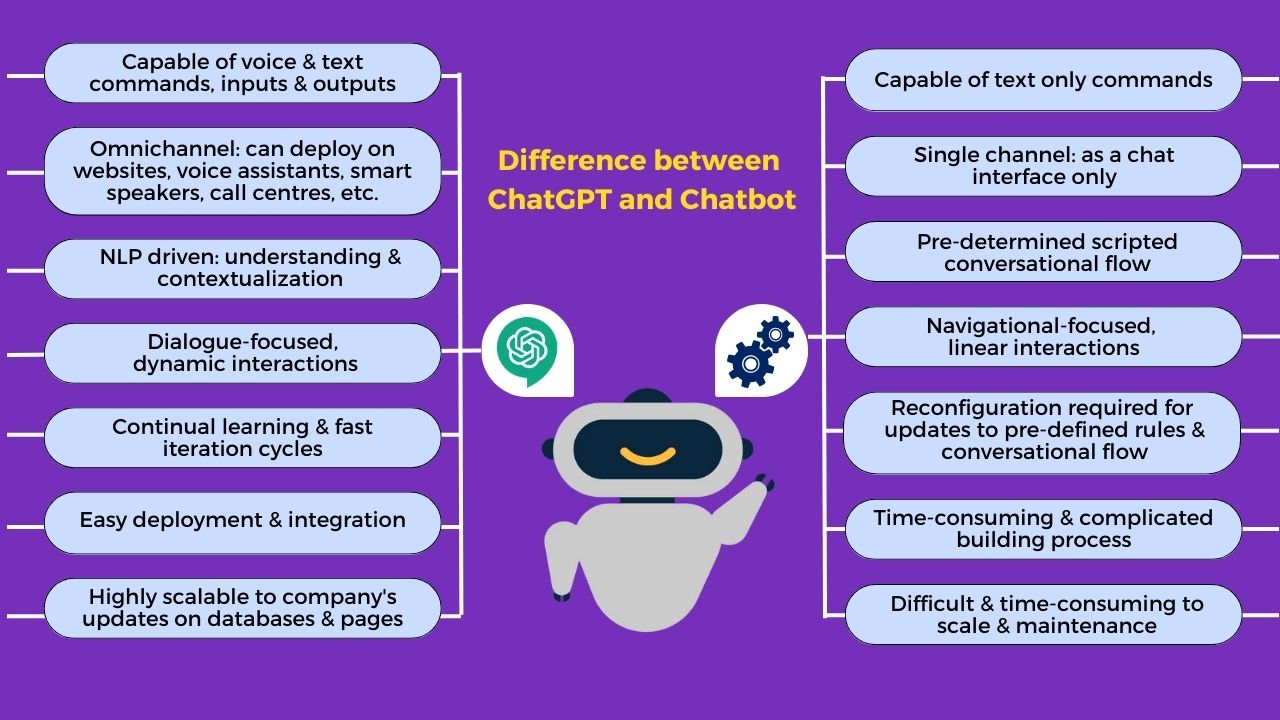
Why are AI Chatbots the future trend?
International research and advisory expert Gartner predicts that customer service systems combining conversational AI will become investment project mainstream in the coming years. More than 50% of businesses will use chatbots for their customer services, and 40% will begin adopting virtual assistants. AI is changing the way businesses communicate internally and with customers, and chatbots will play a key role in achieving automatic learning and flexible automated business communication, with AI and NLP technologies continue to evolve.
If chatbots are combined with ChatGPT’s AI technology, they can better understand and respond to human language, providing a more flexible, intelligent and authentic conversational experience. For example, chatbots can use AI technology to analyze users’ chat content, behavior, and preferences in order to provide personalized product recommendations, service suggestions, or problem-solving assistance. In this way, ChatGPT technology can provide more accurate and personalized responses that enhance customers’ stickiness and satisfaction to the brand. It is likely to bring the following major advantages to companies:
- Speed up customer services: By using AI Chatbots, companies can swiftly answer the customers’ questions and address to the basic customer service needs.
- Improve e-commerce sales experience: Through AI technology, chatbots can help customers quickly find the desired products and answer any product question, with improved conversation quality.
- Automate problem-solving process: AI Chatbots can directly initiate responses based on user inquiries, such as booking arrangements, menu item reservations, etc., to achieve higher efficiency and more cost savings.
- Intelligently collect customer data: By using AI Chatbots to collect customer feedback and suggestions, companies can have a more accurate understanding of customers’ needs and demands.
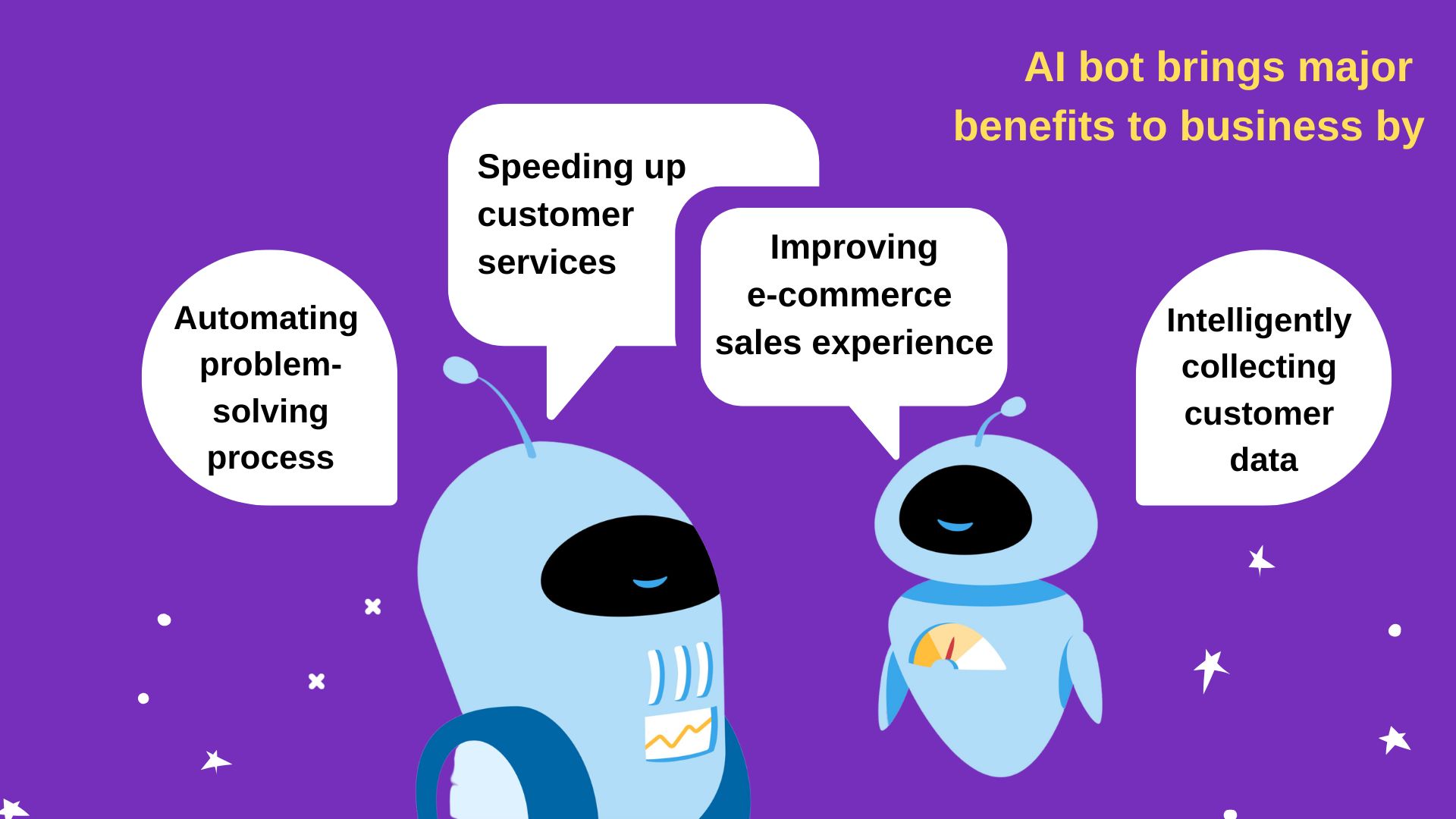
How Chatbots can help the CRM, sales and marketing functions?
In addition to the basic automated customer service functions, AI chatbots can also help businesses plan marketing strategies effectively and maintain good customer relationships.
-
Save labor costs and provide 24-hour customer service
Many companies need to arrange 24-hour shifts for their customer services, such as credit card centre in the banking industry, to meet customers’ instant needs around the clock. Especially during late-night hours, the number of customer inquiries is much lower than during normal hours, but companies still have to bear considerable staffing costs. By sharing customer service tasks with AI chatbots, not only can companies save night shift personnel expenses but also allow customers to get assistance anytime and anywhere.
-
Customize content and deliver brand characteristics
Chatbots can be tailored to meet the needs of corporate customers for online to offline promotional activities. For example, Chatbots can be set up to attract participants scan QR codes on-site, provide entrance guidance and event-related information, allow users to participate in the program’s content through real-time polls and post-event questionnaire, invite participants to join the member community activities – thus continuing their connections with the program at different touchpoints.
-
Categorize users and build sales lists
E-commerce business owners know that it costs high to obtain an active user list, and only with a user list can they further push marketing messages and publicize promotional activities. By interacting with customers on social media platforms and via website interactions, chatbots can find out what products or services that users are interested in, then be able to categorize customers and build sales lists into groups. In this way, marketing resources can be accurately focused on specific consumer groups, and retargeting initiatives can be used to promote products.
-
Long-term interaction and cultivate customer loyalty
Facebook’s latest “Recurring Notifications: Automated Messages” can push messages to users on a daily, weekly, or monthly basis, with message opening rates 3.5 times that of SMS and 20 times that of e-mail. During new product launch or promotional campaign, brands can notify customers as soon as possible and boost the sales conversion rates. Chatbots can also be upgraded to a “membership points system,” setting brand tasks based on marketing goals, such as tracking fan pages or sharing posts. Customers can earn points by completing tasks and then redeem them for coupons or discount codes, creating incentives for customers to continue to revisit and become loyal members who repeatedly purchase.
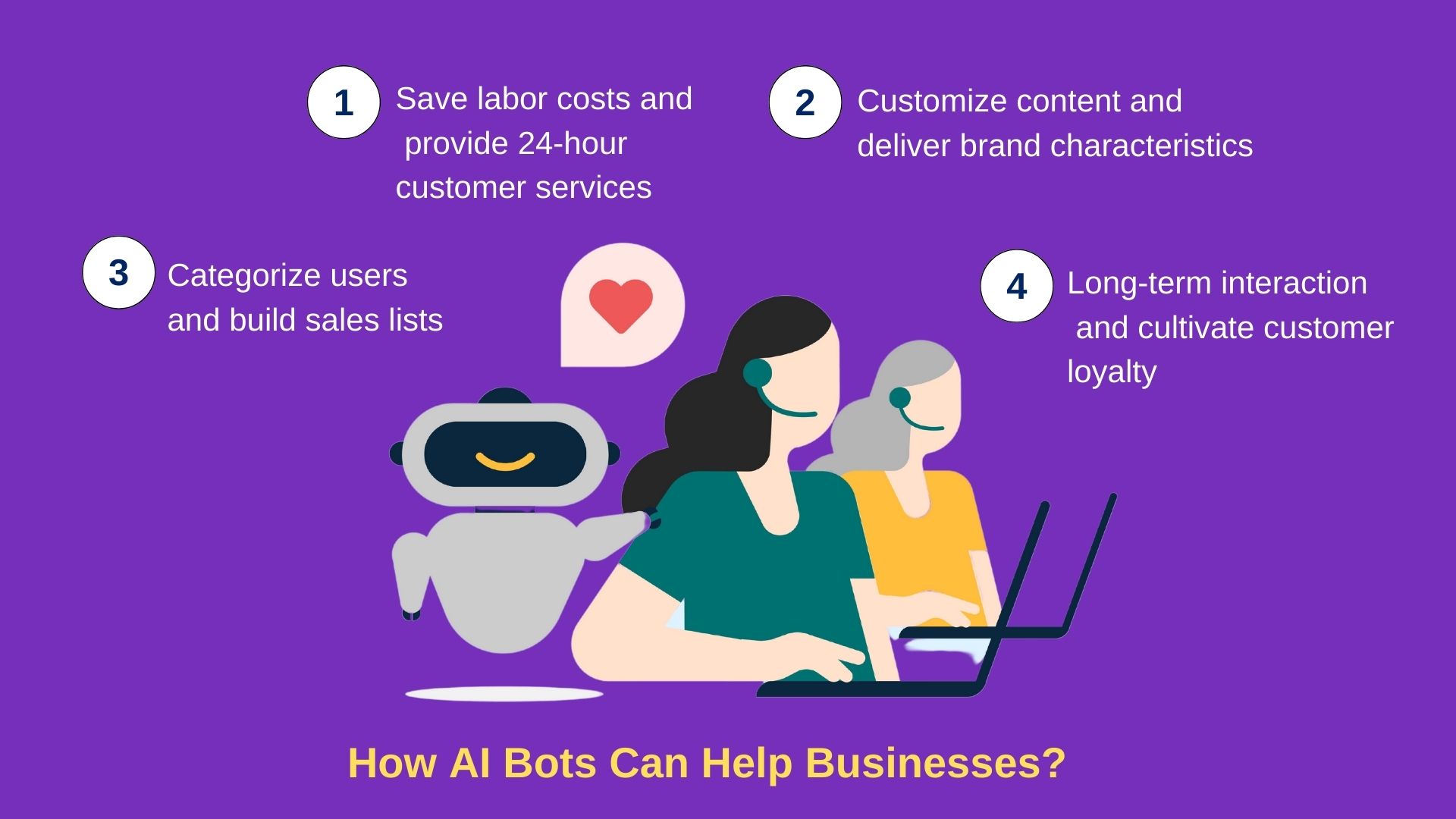
How ChatGPT can be used for customer services?
Most businesses would like to support its customers at any touchpoint along their journey. Incorporating AI-based tools in customer service can simplify your job. With ChatGPT’s large language model, you can improve customer service by about 70% . It is an intelligent, conversational bot that understands the customer’s intent before delivering a solution. This way, it can be an assistant to repetitive tasks and help your customer service agents avoid the fear of a blank page when they need to provide a quick reply. But even though it will speed up some processes, you’ll always need to check what the chatbot provided and ensure the information is accurate and specific.
-
- Quick responses to customer complaints
ChatGPT can be trained to recognize and respond to common customer complaints, such as issues with product quality, shipping delays, or billing errors. When a customer sends a message with a complaint, ChatGPT can analyze it and provide a response that addresses the customer’s concerns and offers potential solutions. Quick responses with ChatGPT can help to improve customer satisfaction by providing timely and effective support for those who are experiencing issues.
- Quick responses to customer complaints

-
- Issue notifications
Getting a quick response is excellent, but how about using AI-powered solutions to proactively inform your clients about potential future issues. It’s thoughtful to anticipate problems rather than wait to respond to them. Here’s what ChatGPT had to say when asked about an email to inform clients about a looming website downtime.
- Issue notifications
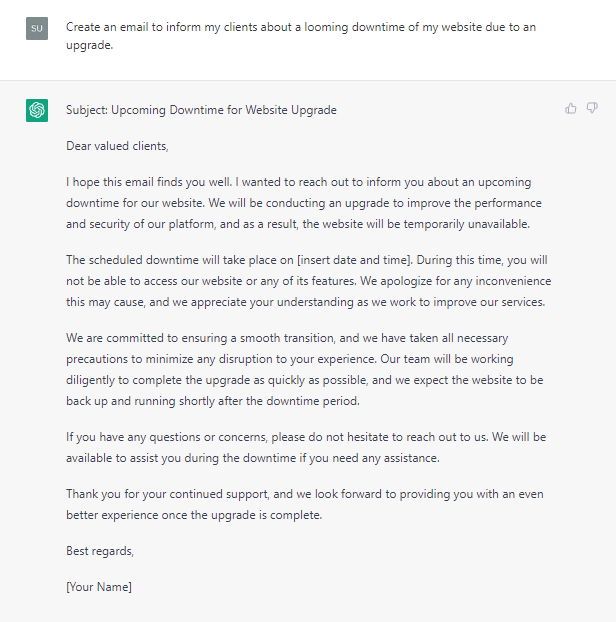
-
- Replying to customer reviews
Customer reviews can make or break your business. Business must react to customer feedback, whether negative or positive. By responding to negative reviews or comments in a timely and effective manner, companies can reduce the impact of negative feedback and improve their overall reputation and brand image. In reality, replying to all customer feedback can be overwhelming. From exhaustion to mental blocks, there are enough reasons to just skim through your customer feedback section. ChatGPT can help unlock fresh ideas on how to respond to customer reviews. The below output from ChatGPT responds to a bad customer review.
- Replying to customer reviews
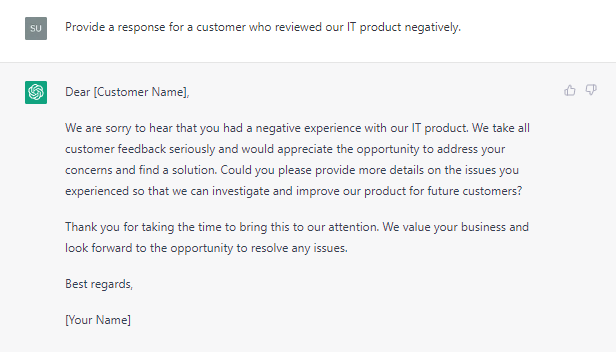
- Answering FAQs
ChatGPT can be trained on a company’s FAQ page or knowledge base to recognize and respond to common customer questions. When a customer sends a message, ChatGPT can analyze it and provide a response that answers the customer’s question or directs them to additional resources. Answering FAQs with ChatGPT can help to improve customer satisfaction and reduce the workload on human customer service representatives by providing customers with quick and accurate responses to their questions. - Sentiment analysis
Sentiment analysis is used to identify customers who are unhappy or dissatisfied with a product or service, and to take steps to address their concerns before they escalate. Sentiment analysis, which is also called opinion mining, uses natural language processing (NLP) and text mining to decipher the emotional context of written materials. ChatGPT can be trained to recognize a wide range of emotions, including happiness, sadness, anger, and frustration. When a customer sends a message, ChatGPT can analyze the message to determine its sentiment and provide a response that is tailored to the customer’s emotional state. In addition to providing real-time support, sentiment analysis with ChatGPT can also be used to identify patterns and trends in customer sentiment over time. By analyzing customer messages over a period of weeks or months, companies can identify areas where they may need to improve their products or services.
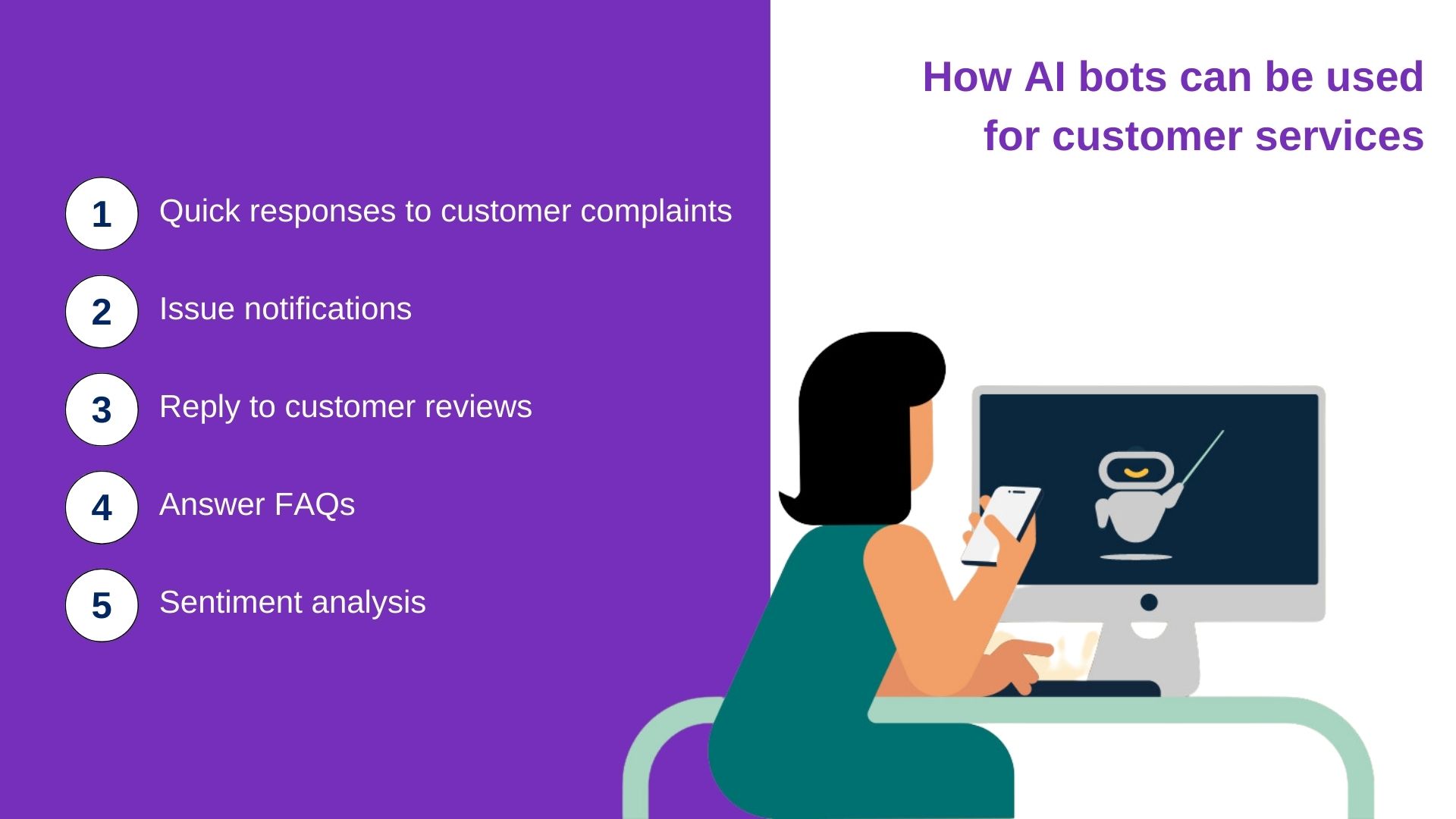
Umm, but there are limitations of ChatGPT for customer services as well…
-
Inability of filling in knowledge gaps
ChatGPT is good at solving problems and skillfully navigates conversational discussions. This is rather transactional – the setting entails accurate information exchange. But a discussion or conversation is not quite what you would describe the interaction between a customer service agent and customer. Chatbots rely heavily on NLP technology to understand and respond to user inquiries. However, current NLP technology is not perfect and ChatGPT may not be able to handle more complex or nuanced customer inquiries. This may require human intervention to resolve certain issues.
-
The need for deliberate, articulated prompts
The customer may be experiencing frustration or stress due to an issue they are trying to resolve. They may not have the patience or inclination to carefully craft their questions in order to get the best answer. This is especially true if the customer is unable to assess the accuracy of the chatbot’s responses from repeated attempts. The customer may feel that the answers they need already exist and that it is the responsibility of ChatGPT or the customer service representative to provide them – rather than having to spend time and effort trying to extract the information they need through their attempts of careful questioning.
-
ChatGPT’s inability to provide personal information
Consumers are more likely to buy from a company that provides a tailored experience. Although customer service chatbot advancements have come in leaps and bounds from first generation bots, it cannot give customer-specific data. If a customer wants to know their personal account information, for example, ChatGPT falls short, due to data privacy and security concerns over its use.
Chatbots are crossing various application scenarios. Automation will enhance chatbot functions and overcome challenges that enterprises currently face when using chatbots. This will bring great positive impact to your customer journey and customer experience. Want to build a chatbot that belongs to your brand? Contact us for more professional advice: [email protected]








Leave a Reply